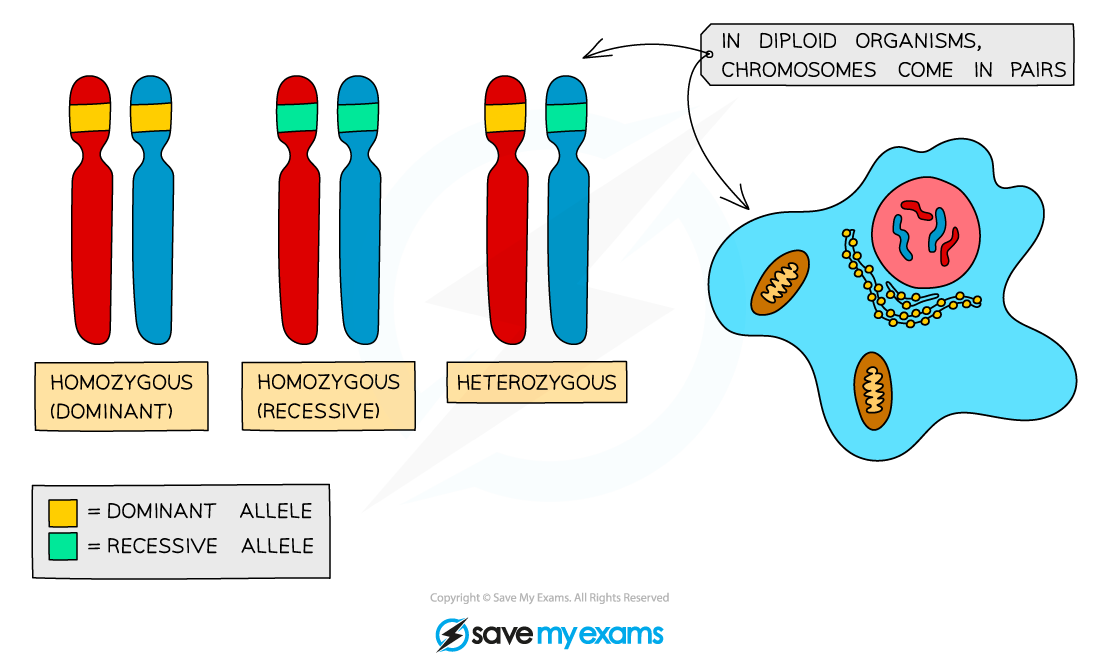Inheritance: Definitions (Cambridge (CIE) O Level Biology): Revision Note
Exam code: 5090
Inheritance Definitions
Inheritance is the transmission of genetic information from generation to generation
Alleles are variations of the same gene
As we have two copies of each chromosome, we have two copies of each gene and therefore two alleles for each gene
One of the alleles is inherited from the mother and the other from the father
These two alleles could be the same or different, for example, an individual has two copies of the gene for eye colour but one allele could code for brown eyes and one allele could code for blue eyes
The observable characteristics of an organism (seen just by looking - like eye colour, or found – like blood type) is called the phenotype
The combination of alleles that control each characteristic is called the genotype
Alleles can be dominant or recessive
A dominant allele only needs to be inherited from one parent in order for the characteristic to show up in the phenotype
A recessive allele needs to be inherited from both parents in order for the characteristic to show up in the phenotype.
If there is only one recessive allele, it will remain hidden and the dominant characteristic will show
If the two alleles of a gene are the same, we describe the individual as being homozygous (homo = same)
An individual could be homozygous dominant (having two copies of the dominant allele), or homozygous recessive (having two copies of the recessive allele)
If the two alleles of a gene are different, we describe the individual as being heterozygous (hetero = different)
Types of genotypes diagram

Alleles of a gene can carry the same instructions or different instructions. You can only inherit two alleles for each gene, and they can be the same or different
We cannot always tell the genotype of an individual for a particular characteristic just by looking at the phenotype – a phenotype associated with a dominant allele will be seen in both a dominant homozygous and a dominant heterozygous genotype
If two individuals who are both identically homozygous for a particular characteristic are bred together, they will produce offspring with exactly the same genotype and phenotype as the parents - we describe them as being ‘pure breeding’ as they will always produce offspring with the same characteristics
Inheritance key terms summary table
Key term | Definition |
|---|---|
Gamete | Gametes are sex cells (in animals; sperm and ovum; in plants pollen nucleus and ovum) |
Chromosome | Chromosomes are thread-like structures of DNA, carrying genetic information in the form of genes. They are located in the nucleus of cells. |
Gene | Genes are short lengths of DNA found on chromosomes. They code for specific proteins. |
Allele | Alleles are different versions of a particular gene. |
Dominant | A dominant allele is always expressed, even if only one copy is present. |
Recessive | A recessive allele is only expressed if two copies are present (therefore no dominant allele present). |
Homozygous | If the two alleles of a gene are the same, we describe the individual as being homozygous (homo = same). |
Heterozygous | If the two alleles of a gene are different, we describe the individual as being heterozygous (hetero = different). |
Genotype | The combination of alleles that control each characteristic is called the genotype. |
Phenotype | The observable characteristics of an organism (seen just by looking - like eye colour, or found through testing - like blood type) is called the phenotype. |

Unlock more, it's free!
Did this page help you?